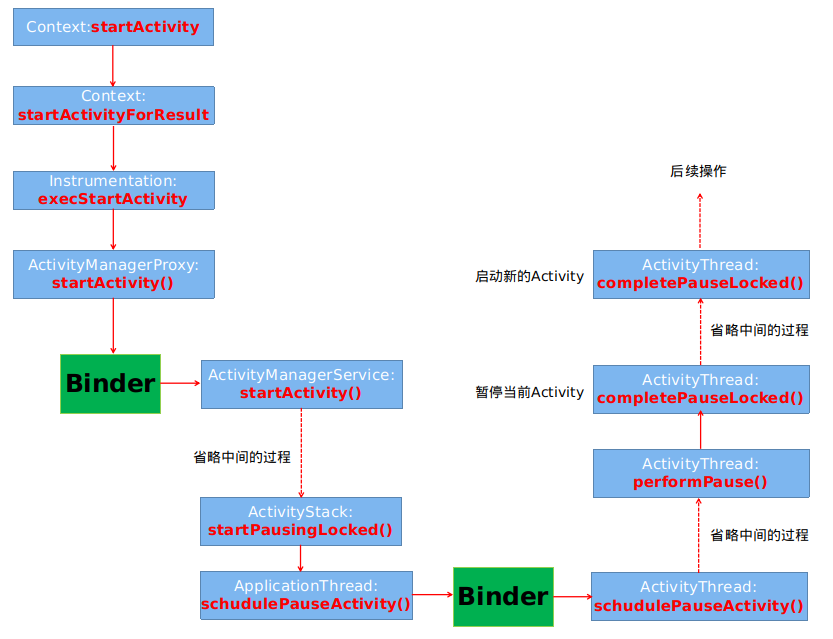大家好,今天想与大家一起分享的是Activity。我们平时接触的最多的就是Activity了,作为四大组件中最为重要的老大,Activity究竟是如何启动的呢?这篇文章将会从源码的角度为大家进行全方位的解析,为了方便大家理解整个的过程,我会用流程图的方式将整个过程串起来,希望对大家有所帮助。
开始吧!
一般我们启动Activity有两种方法,这里我就不再详细说这两种方法的用法了,不过他们都是调用了同样的一个逻辑startActivity。所以我们分析Activity的启动流程就从这个方法开始。1
2
3
4
5
6
7 public void startActivity(Intent intent, @Nullable Bundle options) {
if (options != null) {
startActivityForResult(intent, -1, options);
} else {
startActivityForResult(intent, -1);
}
}
可以看到尽管startActivity()有多种重载方式,但是最终调用的还是startActivityForResult,所以我们只需要看startActivityForResult里面的实现逻辑即可。这里需要注意的一点就是调用了startActivityForResult方法时传入的一个参数为-1,为什么是-1呢?还记得我们如果需要下一个Activity返回数据给目前这个Activity的时候都是调用startActivityForResult方法,不会去调用startActivity,因为startActivity尽管最后还是调用startActivityForResult,但是他设置了requestCode参数为-1,二在startActivityForResult方法中会判断requestCode是否大于等于0,如果小于0就不会返回结果,因此我们都会选择startActivityForResult方法以取回结果,并且设置其code参数大于等于0。下面我们来看看startActivityForResult的实现:1
2
3
4
5
6
7
8
9
10
11
12
13
14
15
16
17
18
19
20
21
22
23
24
25
26
27
28public void startActivityForResult(
@RequiresPermission Intent intent, int requestCode,@Nullable Bundle options) {
//mParent是一个Activity对象,表示该Activity是否由父Activity启动
if (mParent == null) {
options = transferSpringboardActivityOptions(options);
Instrumentation.ActivityResult ar =
mInstrumentation.execStartActivity(
this, mMainThread.getApplicationThread(), mToken, this,
intent, requestCode, options);
if (ar != null) {
mMainThread.sendActivityResult(
mToken, mEmbeddedID, requestCode, ar.getResultCode(),
ar.getResultData());
}
//这里就是判断requestCode的逻辑
if (requestCode >= 0) {
mStartedActivity = true;
}
cancelInputsAndStartExitTransition(options);
} else {
if (options != null) {
mParent.startActivityFromChild(this, intent, requestCode, options);
} else {
mParent.startActivityFromChild(this, intent, requestCode);
}
}
}
在startActivityForResult方法中,首先会判断该Activity是否由父Activity启动,即mParent,如果他是第一个Activity,就会调用Instrumentation的execStartActivity方法,这里再看一下判断requestCode的逻辑:1
2
3if (requestCode >= 0) {
mStartedActivity = true;
}
可以看到在这里确实判断了requestCode的大小,大于等于0的时候才会返回结果,否则是不会的。
继续说回execStartActivity方法,这里就是正真执行Activity启动的操作,解释一下他的几个参数:
this,为启动Activity的对象mMainThread.getApplicationThread(),为Binder对象,是主进程的context对象token,也是一个Binder对象,指向了服务端一个ActivityRecord对象target,为启动的Activityintent,启动的Intent对象requestCode,请求码options,参数
这里的第一个Binder对象在我们的整个分析过程中将扮演者非常重要的作用,如果你对Binder不熟悉的话,请到这里了解有关Binder机制的内容。
接下来是execStartActivity方法:
1 | public ActivityResult execStartActivity( |
这里最重要的就是调用了ActivityManagerNative.getDefault().startActivity(),但是ActivityManagerNative.getDefault()是什么东西呢?我们继续看getDefault()的源码:1
2
3
4
5
6
7
8
9
10
11
12
13
14
15
16
17
18static public IActivityManager getDefault() {
return gDefault.get();
}
private static final Singleton<IActivityManager> gDefault = new Singleton<IActivityManager>() {
protected IActivityManager create() {
IBinder b = ServiceManager.getService("activity");
if (false) {
Log.v("ActivityManager", "default service binder = " + b);
}
IActivityManager am = asInterface(b);
if (false) {
Log.v("ActivityManager", "default service = " + am);
}
return am;
}
};
可以看到其中声明了一个Singleton封装类,其类型是IActivityManager,注意到其中调用了asInterface方法,接着看他做了什么?1
2
3
4
5
6
7
8
9
10
11
12
13
14
15
16
17
18
19
20
21
22
23
24
25
26
27
28
29
30
31
32
33
34
35
36
37
38
39
40
41
42
43
44
45
46
47
48static public IActivityManager asInterface(IBinder obj) {
if (obj == null) {
return null;
}
IActivityManager in =
(IActivityManager)obj.queryLocalInterface(descriptor);
if (in != null) {
return in;
}
return new ActivityManagerProxy(obj);
}
//ActivityManagerProxy:startActivity
public int startActivity(IApplicationThread caller, String callingPackage, Intent intent,
String resolvedType, IBinder resultTo, String resultWho, int requestCode,
int startFlags, ProfilerInfo profilerInfo, Bundle options) throws RemoteException {
Parcel data = Parcel.obtain();
Parcel reply = Parcel.obtain();
data.writeInterfaceToken(IActivityManager.descriptor);
data.writeStrongBinder(caller != null ? caller.asBinder() : null);
data.writeString(callingPackage);
intent.writeToParcel(data, 0);
data.writeString(resolvedType);
data.writeStrongBinder(resultTo);
data.writeString(resultWho);
data.writeInt(requestCode);
data.writeInt(startFlags);
if (profilerInfo != null) {
data.writeInt(1);
profilerInfo.writeToParcel(data, Parcelable.PARCELABLE_WRITE_RETURN_VALUE);
} else {
data.writeInt(0);
}
if (options != null) {
data.writeInt(1);
options.writeToParcel(data, 0);
} else {
data.writeInt(0);
}
mRemote.transact(START_ACTIVITY_TRANSACTION, data, reply, 0);
reply.readException();
int result = reply.readInt();
reply.recycle();
data.recycle();
return result;
}
可以看到asInterface返回了一个ActivityManagerProxy对象,也就是说ActivityManagerNative.getDefault()返回的就是一个ActivityManagerProxy对象,通过之前的BInder机制的文章我们可以知道Proxy是运行在客户端的,客户端通过将参数写入Proxy类,接着Proxy就会通过Binder去远程调用服务端的具体方法,因此,我们只是借用ActivityManagerProxy来调用ActivityManagerService的方法,他们之间的关系如下所示: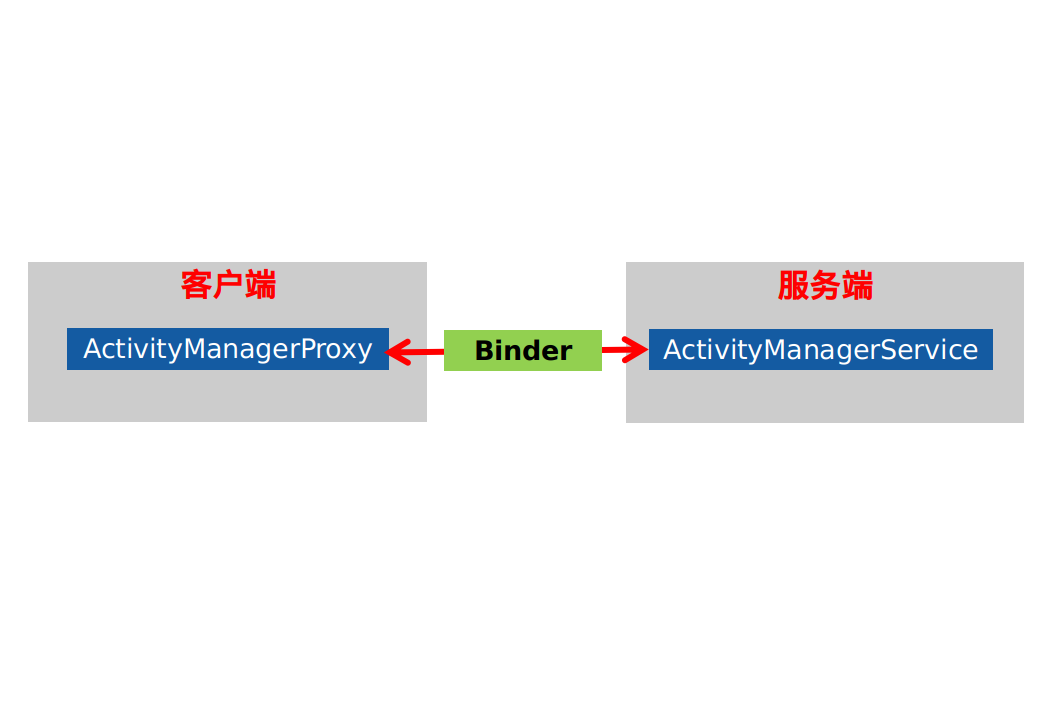
到目前为止Activity的启动流程就是如下所示了,可以看到Activity的启动逻辑来到了AMS中。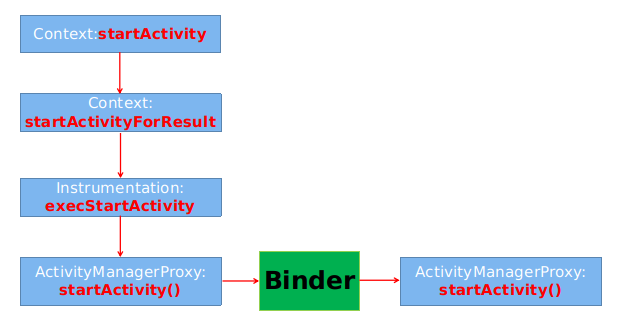
在AMS中启动Activity
1 |
|
在startActivity中直接调用了startActivityAsUser方法,而在startActivityAsUser中则是调用mStackSupervisor.startActivityMayWait方法:1
2
3
4
5
6
7
8
9
10
11
12
13
14
15
16
17final int startActivityLocked(IApplicationThread caller,
Intent intent, String resolvedType, ActivityInfo aInfo,
IVoiceInteractionSession voiceSession, IVoiceInteractor voiceInteractor,
IBinder resultTo, String resultWho, int requestCode,
int callingPid, int callingUid, String callingPackage,
int realCallingPid, int realCallingUid, int startFlags, Bundle options,
boolean ignoreTargetSecurity, boolean componentSpecified, ActivityRecord[] outActivity,
ActivityContainer container, TaskRecord inTask) {
int err = ActivityManager.START_SUCCESS;
...
err = startActivityUncheckedLocked(r, sourceRecord, voiceSession, voiceInteractor,
startFlags, true, options, inTask);
...
return err;
}
这个方法中主要构造了ActivityManagerService端的Activity对象:ActivityRecord,并根据Activity的启动模式执行了相关逻辑。然后调用了startActivityUncheckedLocked方法,而在startActivityUncheckedLocked中则调用了startActivityUncheckedLocked方法,startActivityUncheckedLocked方法则会调用startActivityLocked方法,startActivityLocked又会调用resumeTopActivitiesLocked方法,其最后调用了resumeTopActivityLocked方法。
经过一系列的调用之后,最终来到了startPausingLocked方法,它会执行Activity的onPause方法,从而结束当前的Activity。
首先来看startPausingLocked方法:1
2
3
4
5
6
7
8
9
10
11
12
13
14
15
16
17
18
19
20
21
22
23
24
25final boolean startPausingLocked(boolean userLeaving, boolean uiSleeping, boolean resuming,boolean dontWait) {
...
if (prev.app != null && prev.app.thread != null) {
if (DEBUG_PAUSE) Slog.v(TAG_PAUSE, "Enqueueing pending pause: " + prev);
try {
EventLog.writeEvent(EventLogTags.AM_PAUSE_ACTIVITY,
prev.userId, System.identityHashCode(prev),
prev.shortComponentName);
mService.updateUsageStats(prev, false);
prev.app.thread.schedulePauseActivity(prev.appToken, prev.finishing,
userLeaving, prev.configChangeFlags, dontWait);
} catch (Exception e) {
// Ignore exception, if process died other code will cleanup.
Slog.w(TAG, "Exception thrown during pause", e);
mPausingActivity = null;
mLastPausedActivity = null;
mLastNoHistoryActivity = null;
}
} else {
mPausingActivity = null;
mLastPausedActivity = null;
mLastNoHistoryActivity = null;
}
...
}
这里有一个很重要的地方就是prev.app.thread,其实他就是一个IApplicationThread类型的对象,而ApplicationThread则是ActivityThread的一个内部类,它继承了IApplicationThread,并且都是Binder对象,所以说Appcation是一个客户端,而ActivityThread中是一个服务端,到现在为止,Activity的调用来到了ActivityThread中,如下图所示: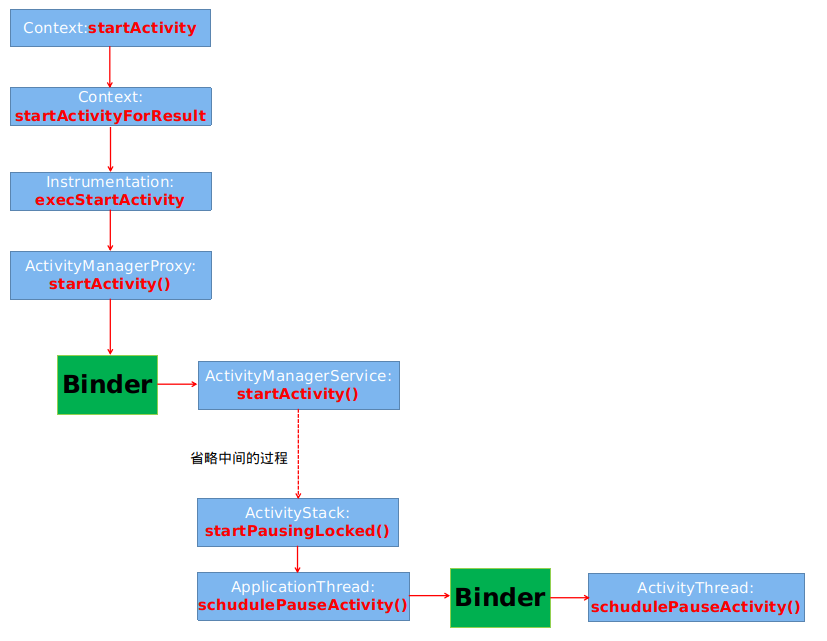
在ActivityThread中pause掉当前Activity
在ActivityThread中则是调用了schedulePauseActivity来执行pause操作:1
2
3
4
5
6
7public final void schedulePauseActivity(IBinder token, boolean finished,boolean userLeaving, int configChanges, boolean dontReport) {
sendMessage(
finished ? H.PAUSE_ACTIVITY_FINISHING : H.PAUSE_ACTIVITY,
token,
(userLeaving ? 1 : 0) | (dontReport ? 2 : 0),
configChanges);
}
可以看到在schedulePauseActivity中则是通过handler来发送消息,消息类型为PAUSE_ACTIVITY_FINISHING,那接下来就应该看收到消息之后如何来处理了,1
2
3
4
5
6
7
8
9
10
11
12
13
14
15
16
17
18
19
20
21
22
23
24
25
26
27private void handlePauseActivity(IBinder token, boolean finished,
boolean userLeaving, int configChanges, boolean dontReport) {
ActivityClientRecord r = mActivities.get(token);
if (r != null) {
//Slog.v(TAG, "userLeaving=" + userLeaving + " handling pause of " + r);
if (userLeaving) {
performUserLeavingActivity(r);
}
r.activity.mConfigChangeFlags |= configChanges;
performPauseActivity(token, finished, r.isPreHoneycomb());
// Make sure any pending writes are now committed.
if (r.isPreHoneycomb()) {
QueuedWork.waitToFinish();
}
// Tell the activity manager we have paused.
if (!dontReport) {
try {
ActivityManagerNative.getDefault().activityPaused(token);
} catch (RemoteException ex) {
}
}
mSomeActivitiesChanged = true;
}
}
可以看到在方法内部通过调用performPauseActivity方法来实现对当前Activity的onPause生命周期方法的回调,具体是调用了performPause方法:1
2
3
4
5
6
7
8
9
10
11
12
13
14final void performPause() {
mDoReportFullyDrawn = false;
mFragments.dispatchPause();
mCalled = false;
onPause();
mResumed = false;
if (!mCalled && getApplicationInfo().targetSdkVersion
>= android.os.Build.VERSION_CODES.GINGERBREAD) {
throw new SuperNotCalledException(
"Activity " + mComponent.toShortString() +
" did not call through to super.onPause()");
}
mResumed = false;
}
可以看到最终是调用了Activity的onPause()方法,接着我们回到handlePauseActivity的第二个方法ActivityManagerNative.getDefault().activityPaused(token),这是应用进程告诉服务进程,当前的Activity已经执行完成onPause方法了,其最后会调用completePauseLocked方法:1
2
3
4
5
6
7
8
9
10
11
12
13
14
15
16
17
18
19
20private void completePauseLocked(boolean resumeNext) {
...
if (resumeNext) {
final ActivityStack topStack = mStackSupervisor.getFocusedStack();
if (!mService.isSleepingOrShuttingDown()) {
mStackSupervisor.resumeTopActivitiesLocked(topStack, prev, null);
} else {
mStackSupervisor.checkReadyForSleepLocked();
ActivityRecord top = topStack.topRunningActivityLocked(null);
if (top == null || (prev != null && top != prev)) {
// If there are no more activities available to run,
// do resume anyway to start something. Also if the top
// activity on the stack is not the just paused activity,
// we need to go ahead and resume it to ensure we complete
// an in-flight app switch.
mStackSupervisor.resumeTopActivitiesLocked(topStack, null, null);
}
}
}
}
可以看到经过了一系列的逻辑之后,又调用了resumeTopActivitiesLocked方法,而在该方法中则是调用了startSpecificActivityLocked 来启动新的Activity。来看看目前的流程图: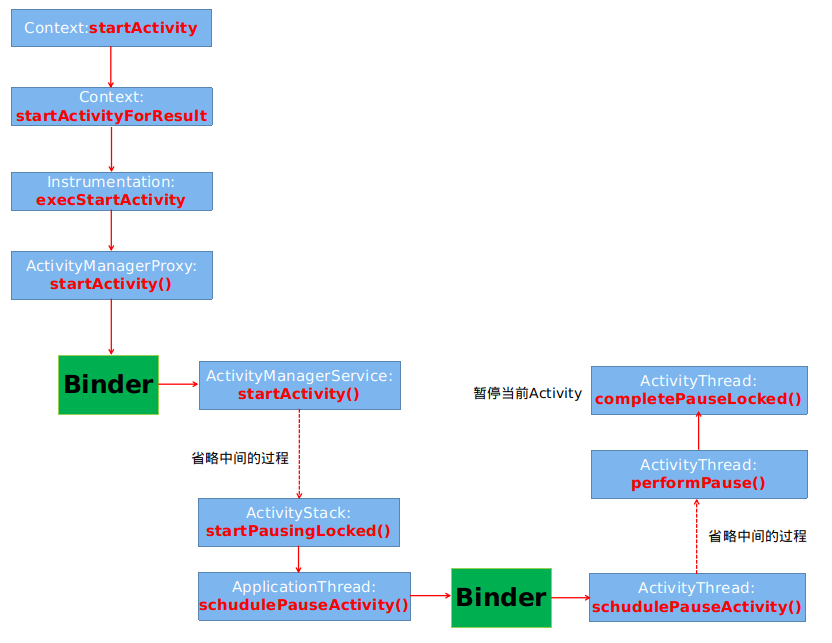
启动新的Activity
在startSpecificActivityLocked方法中,其实现细节则是和调用Activity的pause方法一样,都是通过Handler机制,发送一个启动Activity的消息,接着处理该消息最后启动Activity。其调用的是performLaunchActivity方法:1
2
3
4
5
6
7
8
9
10
11
12
13
14
15
16
17
18
19
20
21
22
23
24
25
26
27
28
29
30
31
32
33
34
35private Activity performLaunchActivity(ActivityClientRecord r, Intent customIntent) {
Activity activity = null;
try {
java.lang.ClassLoader cl = r.packageInfo.getClassLoader();
activity = mInstrumentation.newActivity(
cl, component.getClassName(), r.intent);
StrictMode.incrementExpectedActivityCount(activity.getClass());
r.intent.setExtrasClassLoader(cl);
r.intent.prepareToEnterProcess();
if (r.state != null) {
r.state.setClassLoader(cl);
}
} catch (Exception e) {
if (!mInstrumentation.onException(activity, e)) {
throw new RuntimeException(
"Unable to instantiate activity " + component
+ ": " + e.toString(), e);
}
}
...
activity.mCalled = false;
if (r.isPersistable()) {
mInstrumentation.callActivityOnCreate(activity, r.state, r.persistentState);
} else {
mInstrumentation.callActivityOnCreate(activity, r.state);
}
...
if (!r.activity.mFinished) {
activity.performStart();
r.stopped = false;
}
...
return activity;
}
可以看到最终的Activity对象终于创建出来了,可以看到其过程是使用反射机制创建的,而反射机制在Android系统中的应用也是随处可见。在接下来的过程中还会继续执行Activity的onCreate等一系列的生命周期方法。
最后再来看一下整个过程最终的流程图: